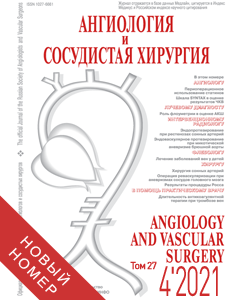Journal «Angiology and Vascular Surgery» •
2007 • VOLUME 13 • №1
CONGENITAL ANOMALIES OF THE INFERIOR VENA CAVA: DIAGNOSIS AND MEDICAL TREATMENT
A.A. Baeshko, G.V. Zhuk, Yu.N. Orlovsky, E.A. Ulezko, T.V. Savitskaya, I.V. Goretskaya, V.V. Egorova, O.A. Somova
Federal Facility Regional Research and Production Centre "Mother and Infant Care" Belorussian State Medical University,
Minsk, Belarus
Analyzed herein are the findings obtained following an examination and medical treatment of five 17-to-39-year-old male patients (average age 25.0±1.83 years) presenting with congenital abnormalities of the inferior vena cava. The diagnosis was made and the level of aplasia was determined based on the findings of a comprehensive instrumental examination (computed and magnetic resonance tomography of the abdominal cavity, duplex scanning of the veins of the lower extremities, of the pelvis and the retroperitoneal space, as well as on the data of pelvic phlebography, and retrograde cavography).
In three of the five patients, the disease appeared to have for the first time manifested itself by a clinical picture of peripheral thrombosis (oedema of the crus and femur), and in the remaining two by an elevated body temperature and shivering, followed by oedema of the both lower limbs.
Two patients were found to have aplasia of the infrarenal segment of the inferior vena cava, two subjects had aplasia of the infra-, renal and partially suprarenal portions of the vessel, and one patient suffered from aplasia of virtually the whole vena cava, excepting a small part of the suprahepatic portion, toward which converged the hepatic veins and the superior polar renal vein.
With the purpose of early diagnosis of congenital abnormalities of the inferior vena cava, the protocol of examination of patients with venous diseases should include ultrasonographic mapping of the supra-, renal and infrarenal portions of the vena cava, and if agenesis is revealed, the use of computed or magnetic resonance tomography, retrograde cavography is strongly recommended. When the diagnosis of IVC aplasia is confirmed, primary medical treatment should consist in prescribing venotonic agents, elastic compression and in cases of deep veins thrombosis -anticoagulant therapy.
KEY WORDS: congenital abnormality, hypoplasia of the inferior vena cava, deep veins thrombosis, chronic venous insufficiency, computed tomography, duplex scanning.
P. 95
ARCHIVES MAGAZINE
2021 (Vol.27)
2020 (Vol.26)
2019 (Vol.25)
2018 (Vol.24)
2017 (Vol.23)
2016 (Vol.22)
2015 (Vol.21)
2014 (Vol.20)
2013 (Vol.19)
2012 (Vol.18)
2011 (Vol.17)
2010 (Vol.16)
2009 (Vol.15)
2008 (Vol.14)
2007 (Vol.13)
2006 (Vol.12)
2005 (Vol.11)
2004 (Vol.10)
2001 (Vol.7)
2000 (Vol.6)
1999 (Vol.5)
1998 (Vol.4)
1997 (Vol.3)


